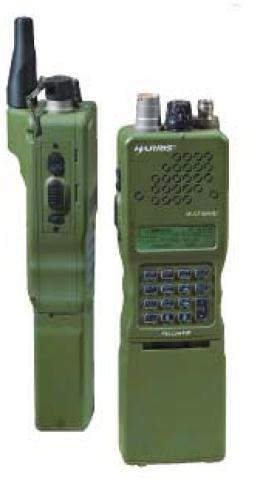
In digital radio, packet radio is the application of packet switching techniques to digital radio communications. Packet radio uses a packet switching protocol as opposed to circuit switching or message switching protocols to transmit digital data via a radio communication link.

Communications security is the discipline of preventing unauthorized interceptors from accessing telecommunications in an intelligible form, while still delivering content to the intended recipients.
In computing, Internet Protocol Security (IPsec) is a secure network protocol suite that authenticates and encrypts packets of data to provide secure encrypted communication between two computers over an Internet Protocol network. It is used in virtual private networks (VPNs).

STU-III is a family of secure telephones introduced in 1987 by the NSA for use by the United States government, its contractors, and its allies. STU-III desk units look much like typical office telephones, plug into a standard telephone wall jack and can make calls to any ordinary phone user. When a call is placed to another STU-III unit that is properly set up, one caller can ask the other to initiate secure transmission. They then press a button on their telephones and, after a 15-second delay, their call is encrypted to prevent eavesdropping. There are portable and militarized versions and most STU-IIIs contained an internal modem and RS-232 port for data and fax transmission. Vendors were AT&T, RCA and Motorola.

The TSEC/KW-26, code named ROMULUS, was an encryption system used by the U.S. Government and, later, by NATO countries. It was developed in the 1950s by the National Security Agency (NSA) to secure fixed teleprinter circuits that operated 24 hours a day. It used vacuum tubes and magnetic core logic, replacing older systems, like SIGABA and the British 5-UCO, that used rotors and electromechanical relays.
The National Security Agency took over responsibility for all U.S. Government encryption systems when it was formed in 1952. The technical details of most NSA-approved systems are still classified, but much more about its early systems have become known and its most modern systems share at least some features with commercial products.
The Electronic Key Management System (EKMS) is a United States National Security Agency led program responsible for Communications Security (COMSEC) key management, accounting, and distribution. Specifically, EKMS generates and distributes electronic key material for all NSA encryption systems whose keys are loaded using standard fill devices, and directs the distribution of NSA produced key material. Additionally, EKMS performs account registration, privilege management, ordering, distribution, and accounting to direct the management and distribution of physical COMSEC material for the services. The common EKMS components and standards facilitate interoperability and commonality among the armed services and civilian agencies.
The Secure Communications Interoperability Protocol (SCIP) is a US standard for secure voice and data communication, for circuit-switched one-to-one connections, not packet-switched networks. SCIP derived from the US Government Future Narrowband Digital Terminal (FNBDT) project. SCIP supports a number of different modes, including national and multinational modes which employ different cryptography. Many nations and industries develop SCIP devices to support the multinational and national modes of SCIP.
SAVILLE is a classified NSA Type 1 encryption algorithm, developed in the late 1960s, jointly by the Government Communications Headquarters (GCHQ) in the UK and the National Security Agency (NSA) in the US. It is used broadly, often for voice encryption, and implemented in many encryption devices.
A universal synchronous and asynchronous receiver-transmitter is a type of a serial interface device that can be programmed to communicate asynchronously or synchronously. See universal asynchronous receiver-transmitter (UART) for a discussion of the asynchronous capabilities of these devices.

Secure voice is a term in cryptography for the encryption of voice communication over a range of communication types such as radio, telephone or IP.

TSEC/KY-68 DSVT, commonly known as Digital Subscriber Voice Terminal, is a US military ruggedized, full- or half-duplex tactical telephone system with a built-in encryption/decryption module for secure traffic.

A fill device or key loader is a module used to load cryptographic keys into electronic encryption machines. Fill devices are usually hand held and electronic ones are battery operated.

The AN/PRC-152 Multiband Handheld Radio, is a portable, compact, tactical software-defined combat-net radio manufactured by Harris Corporation. It is compliant without waivers to the Joint Tactical Radio System (JTRS) Software Communications Architecture (SCA). It has received NSA certification for the transmission of Top Secret data.

The AN/PRC-150(C) Falcon II Manpack Radio, is a tactical HF-SSB/ VHF-FM manpack radio manufactured by Harris Corporation. It holds an NSA certification for Type 1 encryption. The PRC-150 is the manpack HF radio for the Harris Falcon II family of radios, introduced in the early 2000's.
The Joint Range Extension Applications Protocol (JREAP) enables tactical data messages to be transmitted over long-distance networks, e.g. satellite links, thereby extending the range of Tactical Data Links (TDLs).
FASCINATOR is a series of Type 1 encryption modules designed in the late-1980s to be installed in Motorola SECURENET-capable voice radios. These radios were originally built to accept a DES-based encryption module that was not approved by NSA for classified communications. The FASCINATOR modules replaced the DES units and can be used for classified conversations at all levels when used with appropriately classified keys. FASCINATOR operates at 12 kbit/s for encryption and decryption. It is not compatible with DES-based voice systems.
The Advanced Narrowband Digital Voice Terminal (ANDVT) is a secure voice terminal for low bandwidth secure voice communications throughout the U.S. Department of Defense. Devices in the ANDVT family include the AN/USC-43 Tactical Terminal (TACTERM), the KY-99A Miniaturized Terminal (MINTERM), and the KY-100 Airborne Terminal (AIRTERM). ANDVT uses LPC-10 voice compression.
The KIV-7 is a National Security Agency Type-1, single-channel encryptor originally designed in the mid-1990s by AlliedSignal Corporation to meet the demand for secure data communications from personal computers (PC), workstations, and FAXs. It has data rates up to 512 kbit/s and is interoperable with the KG-84, KG-84A, and KG-84C data encryption devices.









